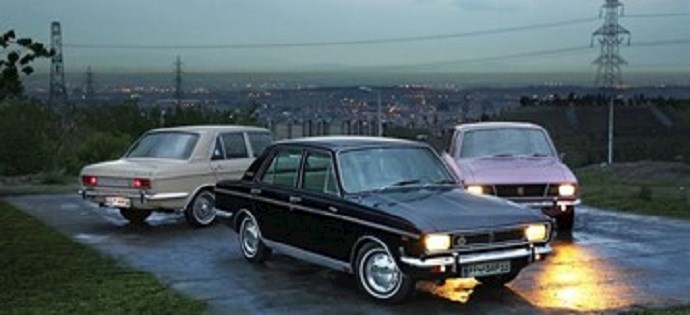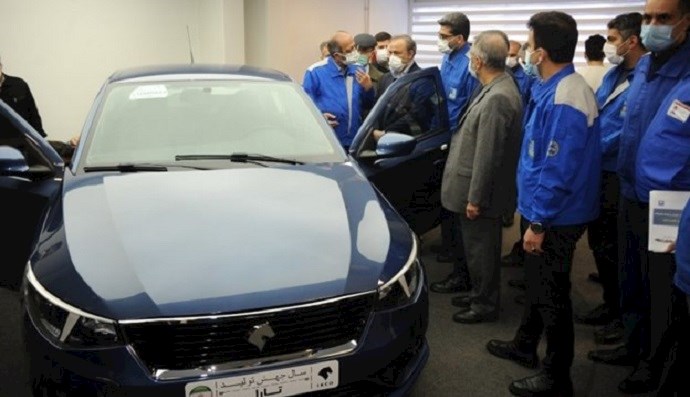Analysis by PMOI/MEK
Iran, January 1, 2021—“It doesn’t even start!” says the reporter of Khabarnegaran-e Javan state-run news agency during the unveiling ceremony of the “Iranian star,” Iran’s new-made car Tara in late December. Tara, unveiled before by the Iranian regime’s president Hassan Rouhani in early 2020, was once again unveiled by the regime’s minister of industry. But Tara did not start when the minister wanted to start it up in front of the press, leaving another embarrassment for the regime’s minister and Iran’s vehicle industry.
Iran Khodro, the largest carmaker in #Iran, unveiled their new "Tara" recently. During the ceremony, vehicle broke down and the engine didn't even start.
"The battery is dead," a man is heard saying.
And the exact same vehicle was introduced last year under a different name. pic.twitter.com/0dZCEbCdLE
— People's Mojahedin Organization of Iran (PMOI/MEK) (@Mojahedineng) December 27, 2020
Tara, in fact, is nothing but a modified version of the Peugeot 301, with small differences in the body design. Tara is made by one of Iran’s oldest vehicle factories “Iran Khodro Company (IKCO)” founded in 1962. Tara is just a clue to get to know Iran’s disastrous automaking industry. While SAIPA, founded in 1965, is another of Iran’s main disastrous automakers, looking into IKCO is enough to find out the destructive role of the mullahs in this field.
Iran’s automaking industry has been a victim of two dictatorships of the Shah and the mullahs. As a private sector company, IKCO (the original name was Iran National Company) was first producing bus hulls in 1962. In 1966, IKCO started manufacturing sedans. The Shah forced IKCO to sign a contract with the British company Rootes, which was on the edge of bankruptcy. This was one of Shah’s gifts to his masters in the UK, courtesty of the Iranian people’s pocket. “We cannot decide to choose many things in our life,” said the managing director of IKCO at the time when asked why he had signed a contract with the bankrupt Rootes. He was of course referring to the role the Shah regime played in the decisoin. IKCO was tasked with assembling the British-made parts to produce the Paykan sedan.
After seizing power during the 1979 revolution in Iran, the mullahs took hold of industries, and IKCO was sheltered by the governmental National Industries Organization. The mullahs continued down a path that was worse than the Shah’s. While Paykan was far outdated at the time, the mullahs purchased the production line from Rootes and continued its production as before until 2005.

Paykan was Iran’s National Vehicle up until 2005
During these years IKCO also assembled some models of Peugeot. In 1996, IKCO declared that it would replace Paykan with the “new Paykan.” The new Paykan prototype was a completely new-designed car, designed by foreign companies using the Peugeot 405 chassis. But after costing a lot of money ($2-3 billion according to some estimates), Iran did not see the manufacture of the new Paykan. It is not clear how regime authorities spent the money on the project, but they just said the product of the new Paykan “was not economical”.
IKCO then spent over one billion dollars on designing a new “national car” called Samand. It was also designed based on the Peugeot 405 platform, a technology dating to 20 years ago. And as it could be guessed, Samand was disqualified in the safety and crash test conducted by Thatcham Research, a European New Car Assessment Program (Euro NCAP) at its accredited test facility in London. Samand also raised many complaints in Iran due to its low quality and poor performance.

Samand crash test in Thatcham Research
To date, IKCO has continued changing the design of its pre-made cars or combining different parts of various vehicles, pretending they are making new designs; however, to be fair, only their names are new.
Meanwhile, the Iranian people were the only party that paid the price of these policies. SAIPA’s famous car, Pride, which was being manufactured in Iran until the summer of 2020, is known as a “mobile coffin.” Pride set a record in killing its passengers. “Some 2,454 people were killed due to Pride accidents, and this is how Pride has recorded 13.6 percent of accidents which led to the death of passengers,” the head of the Forensic Medicine Organization told the state-run news agency Tasnim in April 2014.
The question is why a regime that claims it can send a satellite into space cannot produce a simple domestic car? The South Korean carmaker Hyundai initiated vehicle production five years after the IKCO, in 1967. Hyundai started with car assembly and produced its first domestic car in 1976—almost ten years later. Now, Hyundai is one of the world’s prominent carmakers. What is the difference between the vehicle industry in South Korea and Iran?
Both in the Shah and mullahs’ era, IKCO and other major factories were under the influence of corrupt policies of the regimes ruling Iran. The Shah did not want the industry to be independent, and the mullahs completely ruined the industry through corruption and incompetent policies.
The mullahs first monopolized Iran’s vehicle market for their limited car manufacturers like IKCO and SAIPA. In this market, these companies sell their low-quality cars at any price they want, and the Iranian people have no other choice—now the regime doesn’t officially import cars except those luxury cars smuggled by the IRGC and other officials. “My friend registered for buying a new Paykan from IKCO. When he received it, it had many technical problems even before exiting the factory. Nobody cared about his complaints in the factory, and he had to spend some more money to fix it,” according to a witness report.
Now, an outdated Samand Soren 2020 costs about 2.7 billion rials (around $11,000) which is equal to the price of a Ford Figo 2020. Meanwhile, the regime’s car manufacturers are hoarding cars in their parking lots to increase car prices in the market more than before.
Regime officials' approach made the situation clearer. “Those who do not want to buy domestic cars are ‘counter-revolutionaries,’” said the regime’s former minister of industry Mohammad Reza Nematzadeh, accusing those Iranians who boycott vehicles produced in the regime’s factories, according to the state-run Tabnak news agency in August 2015.
The mullahs manufactured Paykan for 26 years, and it is known as the IKCO’s “cash cow.” The mullahs sold around two million Paykans. Iran’s monopolized market forced people to buy such unsafe and outdated cars. Therefore, the mullahs did not need to develop manufacturing technology and spend more money. This approach of course rendered losses for the country in many periods but not for IKCO authorities and the mullahs. Since IKCO is under the government’s shelter, the mullahs inject Iran’s wealth and money into the company to keep IKCO alive. As a result, the authorities’ cash cow can continue filling the mullahs’ pockets.
In 2017, Iran’s state-run TV also admitted that Iran’s vehicle parts manufacturing industry is basically a mafia gang. A faculty member of the University of Science and Technology told Channel Three that the companies under the control of the authorities benefit from the corruption in the import of raw materials. “This mafia cannot carry out embezzlement if they work with universities to design and produce parts in Iran. But they can benefit from bribery and corruption when they import parts from abroad,” said Mohammad Hassan Shojaie.
“Numerous gangs are directing the IKCO. When a new president or minister takes office, he replaces the previous board with his gang, and they plan their own policies to fill their own pockets,” said an IKCO employee.
“In the ten previous Majlis (parliaments) at least 8,000 employees of IKCO were introduced by MPs to be hired… One certain MP alone had introduced 300 people to IKCO,” said the member of regime’s parliament Ahmad Amir Abadi in an interview in June 2020.
The mullahs’ policy is nothing but plundering Iran’s resources, and they are not about to improve Iran in any field except those strengthening their dictatorship i.e., terrorism, costly missile and nuclear program, etc. This is the main reason that Tara doesn’t start, or better put, it’s why Iran’s vehicle manufacturing industry has not yet started and has been broken apart.





